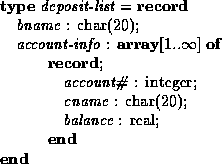- Storage of multiple items in a file
- Record types allowing variable field size
- Record types allowing repeating fields

Account-information is an array with an arbitrary number of elements.
 ) to the end of each record.
Then we can store each record as a string of successive bytes.
(See figure 7.9)
) to the end of each record.
Then we can store each record as a string of successive bytes.
(See figure 7.9)
Byte string representation has several disadvantages:
- It is not easy to re-use space left by a deleted record
- In general, there is no space for records to grow longer. (Must move to expand, and record may be pinned.)
- Reserved space - uses fixed-length records large enough to accommodate the largest variable-length record. (Unused space filled with end-of-record symbol.)
- Pointers - represent by a list of fixed-length records, chained together.
- If most records are of near-maximum length this method is useful.
- Otherwise, space is wasted.
- Then the pointer method may be used (figure 7.11).
- Disadvantage is that space is wasted in successive records in a chain
as non-repeating fields are still present.
- To overcome this last disadvantage we can split records into two blocks
(See figure 7.12)
- Anchor block - contains first records of a chain
- Overflow block - contains records other than first in the chain.
- Now all records in a block have the same length, and there is no wasted space.


